Criminology Essay: Neighbourhood/Community vs Zero Tolerance Policing
VerifiedAdded on 2023/01/09
|9
|2675
|99
Essay
AI Summary
This essay critically examines the contrasting roles of neighbourhood/community policing and zero-tolerance policing within the framework of a liberal democracy. It begins by defining the core elements of community policing, such as problem-solving, citizen involvement, and decentralization, highlighting its philosophy of fostering relationships between law enforcement and local communities to prevent crime and improve quality of life. The essay then explores the concept of zero-tolerance policing, detailing its emphasis on strict enforcement of laws and penalties for violations, particularly in addressing street crimes. A critical analysis follows, evaluating the effectiveness and potential drawbacks of both policing styles. The discussion includes examples of implementation, such as the use of zero-tolerance in New York City and London, and addresses issues such as potential for police brutality, long-term outcomes, and the impact on targeted individuals. The essay concludes with a reflection on the research process, time management, and areas for improvement, along with a summary of the key findings and implications of the comparative analysis of policing styles.
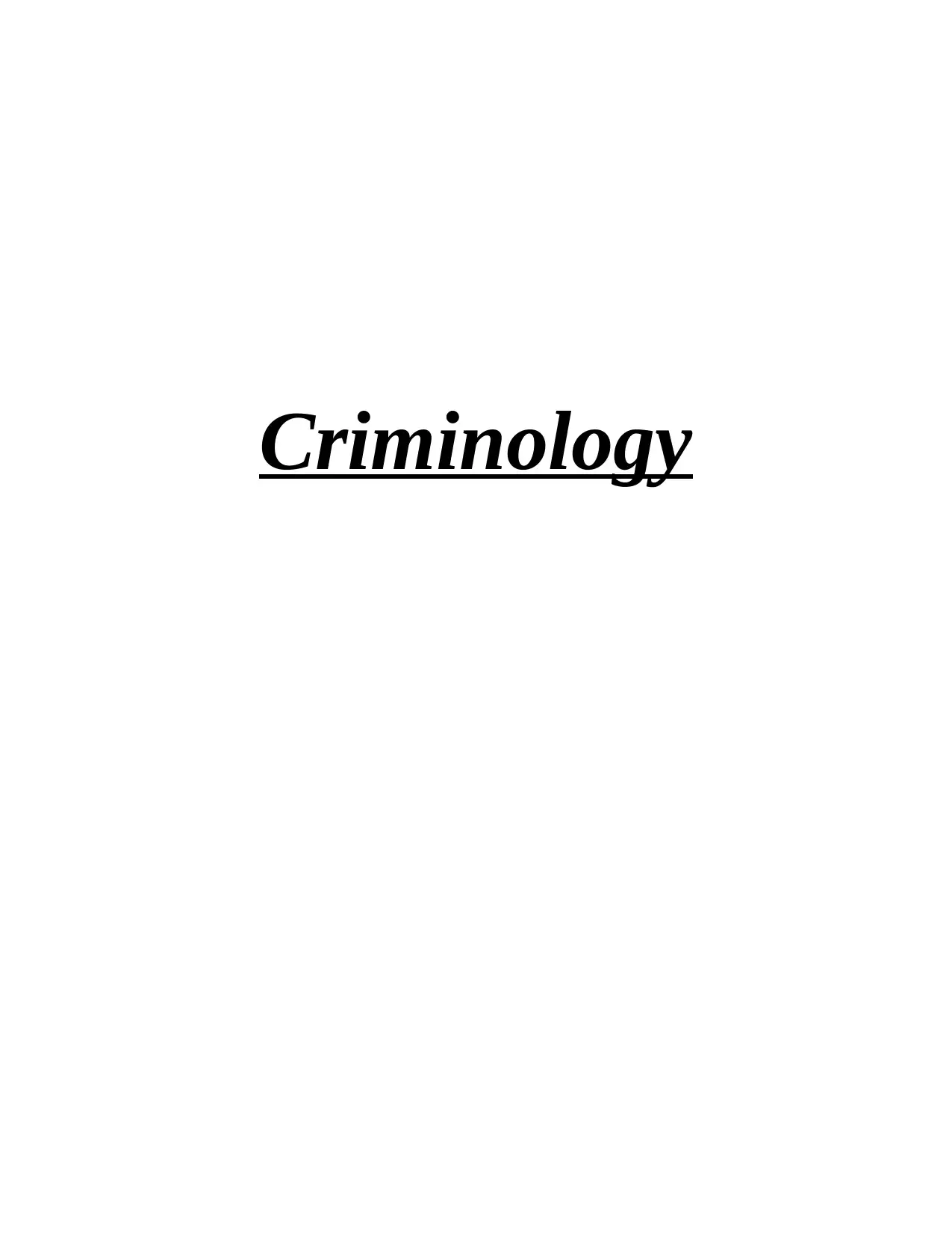
Criminology
Paraphrase This Document
Need a fresh take? Get an instant paraphrase of this document with our AI Paraphraser
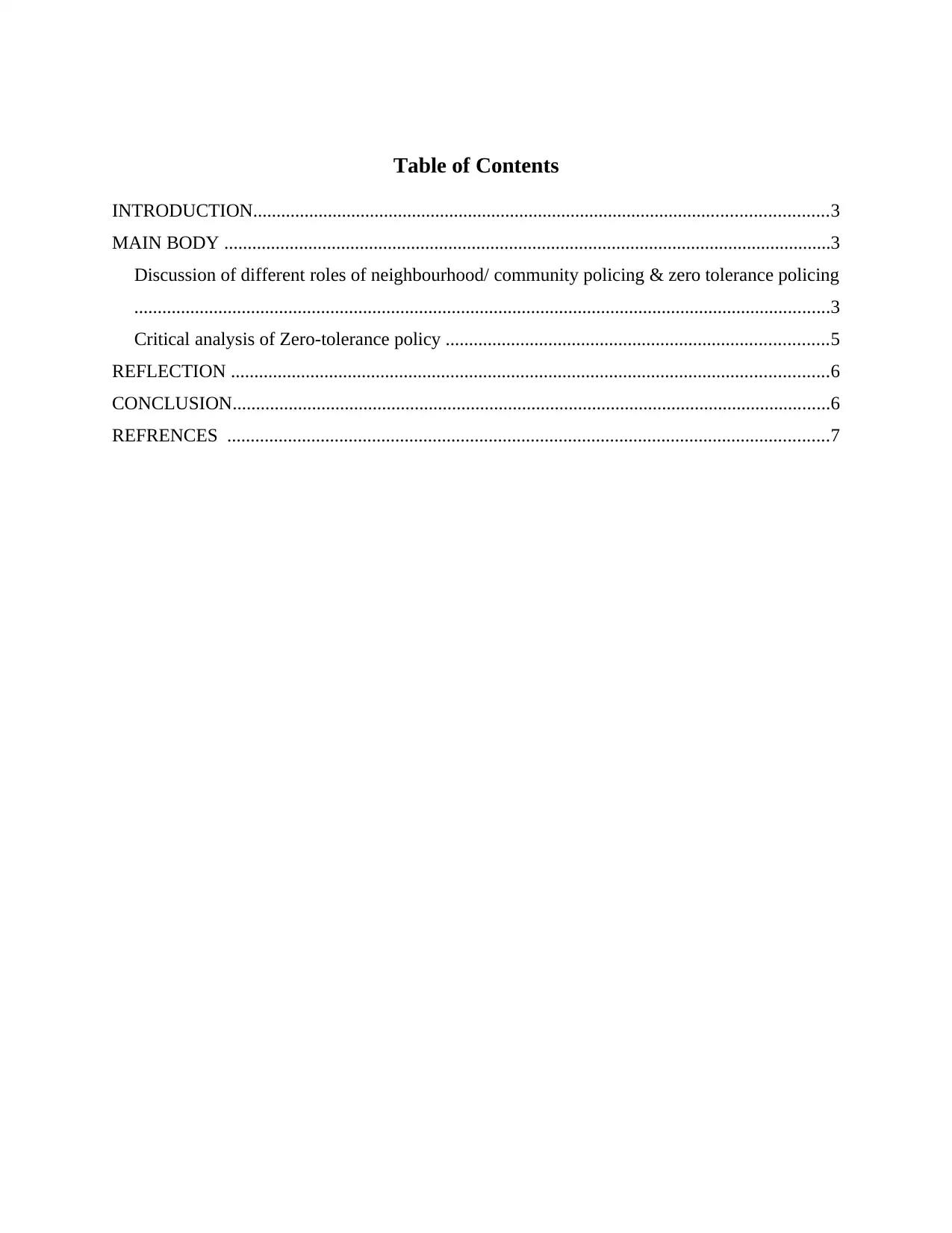
Table of Contents
INTRODUCTION...........................................................................................................................3
MAIN BODY ..................................................................................................................................3
Discussion of different roles of neighbourhood/ community policing & zero tolerance policing
.....................................................................................................................................................3
Critical analysis of Zero-tolerance policy ..................................................................................5
REFLECTION ................................................................................................................................6
CONCLUSION................................................................................................................................6
REFRENCES .................................................................................................................................7
INTRODUCTION...........................................................................................................................3
MAIN BODY ..................................................................................................................................3
Discussion of different roles of neighbourhood/ community policing & zero tolerance policing
.....................................................................................................................................................3
Critical analysis of Zero-tolerance policy ..................................................................................5
REFLECTION ................................................................................................................................6
CONCLUSION................................................................................................................................6
REFRENCES .................................................................................................................................7
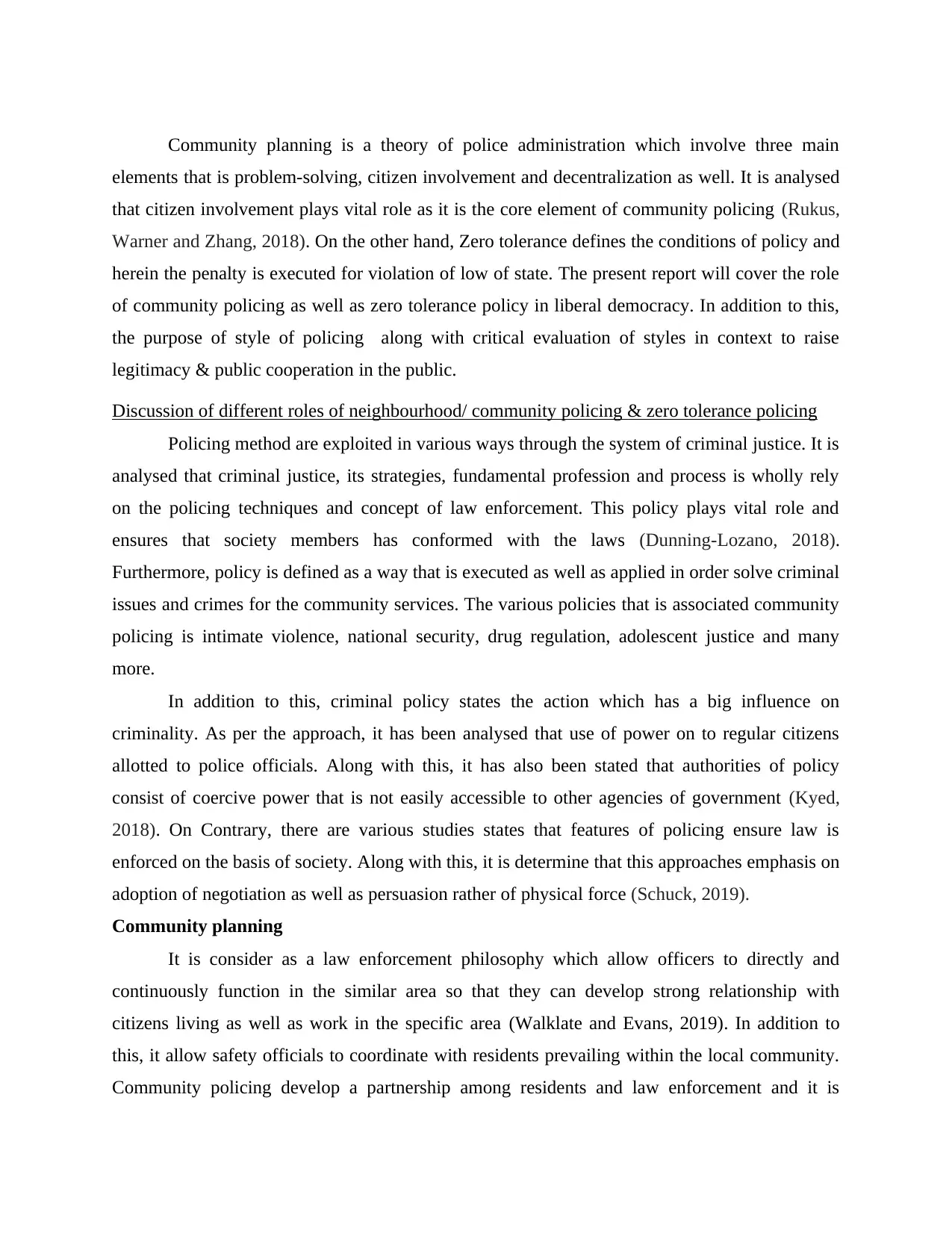
Community planning is a theory of police administration which involve three main
elements that is problem-solving, citizen involvement and decentralization as well. It is analysed
that citizen involvement plays vital role as it is the core element of community policing (Rukus,
Warner and Zhang, 2018). On the other hand, Zero tolerance defines the conditions of policy and
herein the penalty is executed for violation of low of state. The present report will cover the role
of community policing as well as zero tolerance policy in liberal democracy. In addition to this,
the purpose of style of policing along with critical evaluation of styles in context to raise
legitimacy & public cooperation in the public.
Discussion of different roles of neighbourhood/ community policing & zero tolerance policing
Policing method are exploited in various ways through the system of criminal justice. It is
analysed that criminal justice, its strategies, fundamental profession and process is wholly rely
on the policing techniques and concept of law enforcement. This policy plays vital role and
ensures that society members has conformed with the laws (Dunning-Lozano, 2018).
Furthermore, policy is defined as a way that is executed as well as applied in order solve criminal
issues and crimes for the community services. The various policies that is associated community
policing is intimate violence, national security, drug regulation, adolescent justice and many
more.
In addition to this, criminal policy states the action which has a big influence on
criminality. As per the approach, it has been analysed that use of power on to regular citizens
allotted to police officials. Along with this, it has also been stated that authorities of policy
consist of coercive power that is not easily accessible to other agencies of government (Kyed,
2018). On Contrary, there are various studies states that features of policing ensure law is
enforced on the basis of society. Along with this, it is determine that this approaches emphasis on
adoption of negotiation as well as persuasion rather of physical force (Schuck, 2019).
Community planning
It is consider as a law enforcement philosophy which allow officers to directly and
continuously function in the similar area so that they can develop strong relationship with
citizens living as well as work in the specific area (Walklate and Evans, 2019). In addition to
this, it allow safety officials to coordinate with residents prevailing within the local community.
Community policing develop a partnership among residents and law enforcement and it is
elements that is problem-solving, citizen involvement and decentralization as well. It is analysed
that citizen involvement plays vital role as it is the core element of community policing (Rukus,
Warner and Zhang, 2018). On the other hand, Zero tolerance defines the conditions of policy and
herein the penalty is executed for violation of low of state. The present report will cover the role
of community policing as well as zero tolerance policy in liberal democracy. In addition to this,
the purpose of style of policing along with critical evaluation of styles in context to raise
legitimacy & public cooperation in the public.
Discussion of different roles of neighbourhood/ community policing & zero tolerance policing
Policing method are exploited in various ways through the system of criminal justice. It is
analysed that criminal justice, its strategies, fundamental profession and process is wholly rely
on the policing techniques and concept of law enforcement. This policy plays vital role and
ensures that society members has conformed with the laws (Dunning-Lozano, 2018).
Furthermore, policy is defined as a way that is executed as well as applied in order solve criminal
issues and crimes for the community services. The various policies that is associated community
policing is intimate violence, national security, drug regulation, adolescent justice and many
more.
In addition to this, criminal policy states the action which has a big influence on
criminality. As per the approach, it has been analysed that use of power on to regular citizens
allotted to police officials. Along with this, it has also been stated that authorities of policy
consist of coercive power that is not easily accessible to other agencies of government (Kyed,
2018). On Contrary, there are various studies states that features of policing ensure law is
enforced on the basis of society. Along with this, it is determine that this approaches emphasis on
adoption of negotiation as well as persuasion rather of physical force (Schuck, 2019).
Community planning
It is consider as a law enforcement philosophy which allow officers to directly and
continuously function in the similar area so that they can develop strong relationship with
citizens living as well as work in the specific area (Walklate and Evans, 2019). In addition to
this, it allow safety officials to coordinate with residents prevailing within the local community.
Community policing develop a partnership among residents and law enforcement and it is
⊘ This is a preview!⊘
Do you want full access?
Subscribe today to unlock all pages.

Trusted by 1+ million students worldwide
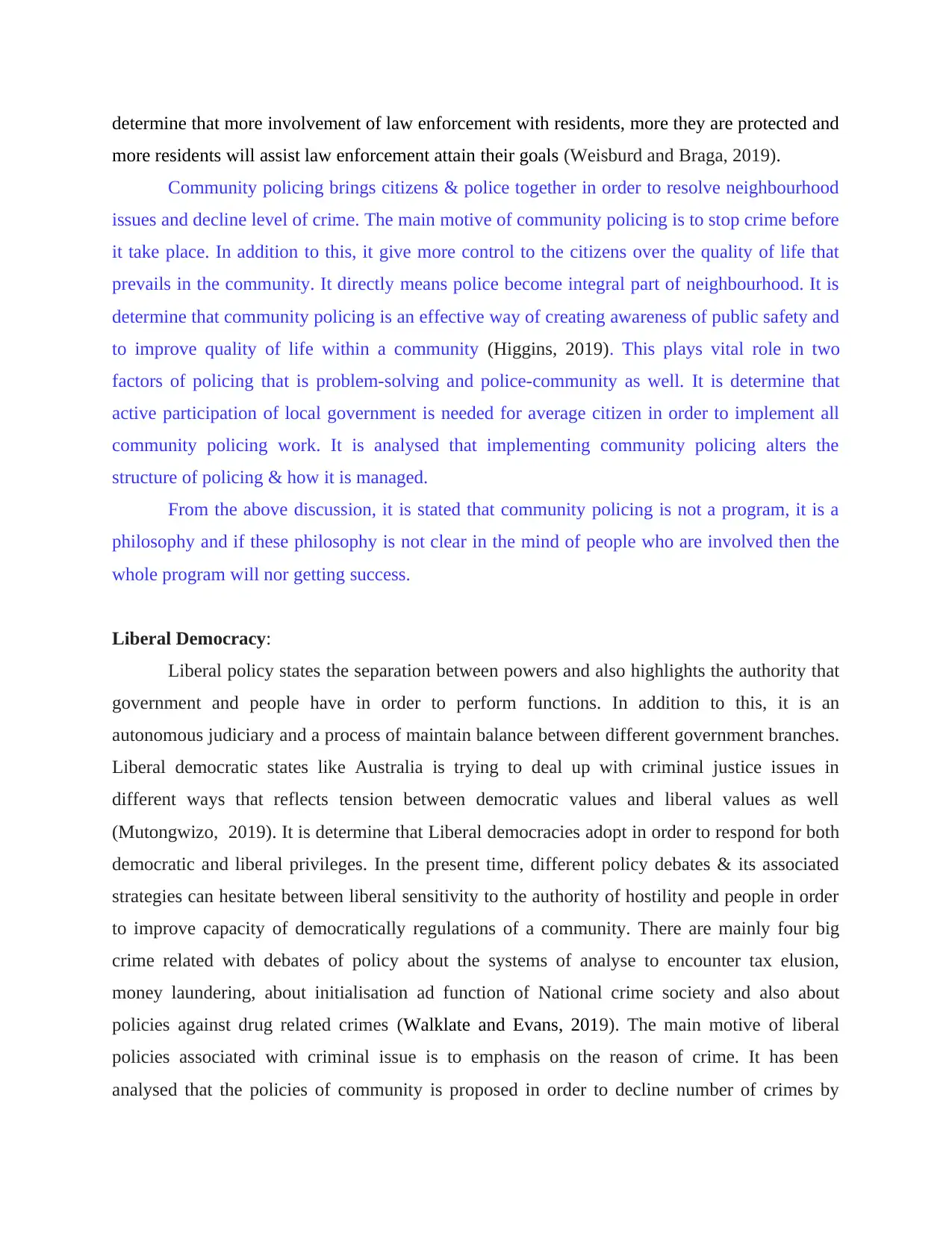
determine that more involvement of law enforcement with residents, more they are protected and
more residents will assist law enforcement attain their goals (Weisburd and Braga, 2019).
Community policing brings citizens & police together in order to resolve neighbourhood
issues and decline level of crime. The main motive of community policing is to stop crime before
it take place. In addition to this, it give more control to the citizens over the quality of life that
prevails in the community. It directly means police become integral part of neighbourhood. It is
determine that community policing is an effective way of creating awareness of public safety and
to improve quality of life within a community (Higgins, 2019). This plays vital role in two
factors of policing that is problem-solving and police-community as well. It is determine that
active participation of local government is needed for average citizen in order to implement all
community policing work. It is analysed that implementing community policing alters the
structure of policing & how it is managed.
From the above discussion, it is stated that community policing is not a program, it is a
philosophy and if these philosophy is not clear in the mind of people who are involved then the
whole program will nor getting success.
Liberal Democracy:
Liberal policy states the separation between powers and also highlights the authority that
government and people have in order to perform functions. In addition to this, it is an
autonomous judiciary and a process of maintain balance between different government branches.
Liberal democratic states like Australia is trying to deal up with criminal justice issues in
different ways that reflects tension between democratic values and liberal values as well
(Mutongwizo, 2019). It is determine that Liberal democracies adopt in order to respond for both
democratic and liberal privileges. In the present time, different policy debates & its associated
strategies can hesitate between liberal sensitivity to the authority of hostility and people in order
to improve capacity of democratically regulations of a community. There are mainly four big
crime related with debates of policy about the systems of analyse to encounter tax elusion,
money laundering, about initialisation ad function of National crime society and also about
policies against drug related crimes (Walklate and Evans, 2019). The main motive of liberal
policies associated with criminal issue is to emphasis on the reason of crime. It has been
analysed that the policies of community is proposed in order to decline number of crimes by
more residents will assist law enforcement attain their goals (Weisburd and Braga, 2019).
Community policing brings citizens & police together in order to resolve neighbourhood
issues and decline level of crime. The main motive of community policing is to stop crime before
it take place. In addition to this, it give more control to the citizens over the quality of life that
prevails in the community. It directly means police become integral part of neighbourhood. It is
determine that community policing is an effective way of creating awareness of public safety and
to improve quality of life within a community (Higgins, 2019). This plays vital role in two
factors of policing that is problem-solving and police-community as well. It is determine that
active participation of local government is needed for average citizen in order to implement all
community policing work. It is analysed that implementing community policing alters the
structure of policing & how it is managed.
From the above discussion, it is stated that community policing is not a program, it is a
philosophy and if these philosophy is not clear in the mind of people who are involved then the
whole program will nor getting success.
Liberal Democracy:
Liberal policy states the separation between powers and also highlights the authority that
government and people have in order to perform functions. In addition to this, it is an
autonomous judiciary and a process of maintain balance between different government branches.
Liberal democratic states like Australia is trying to deal up with criminal justice issues in
different ways that reflects tension between democratic values and liberal values as well
(Mutongwizo, 2019). It is determine that Liberal democracies adopt in order to respond for both
democratic and liberal privileges. In the present time, different policy debates & its associated
strategies can hesitate between liberal sensitivity to the authority of hostility and people in order
to improve capacity of democratically regulations of a community. There are mainly four big
crime related with debates of policy about the systems of analyse to encounter tax elusion,
money laundering, about initialisation ad function of National crime society and also about
policies against drug related crimes (Walklate and Evans, 2019). The main motive of liberal
policies associated with criminal issue is to emphasis on the reason of crime. It has been
analysed that the policies of community is proposed in order to decline number of crimes by
Paraphrase This Document
Need a fresh take? Get an instant paraphrase of this document with our AI Paraphraser
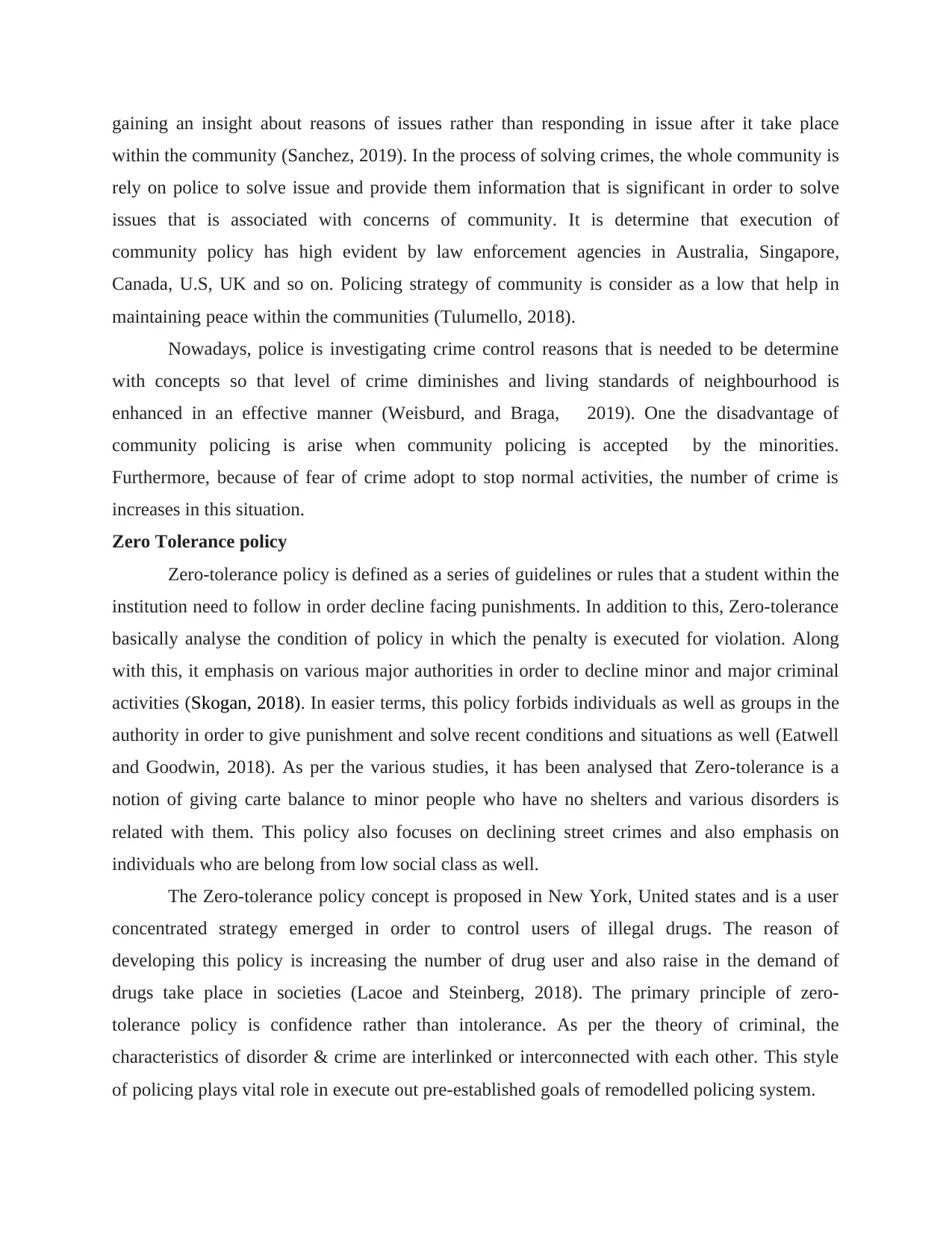
gaining an insight about reasons of issues rather than responding in issue after it take place
within the community (Sanchez, 2019). In the process of solving crimes, the whole community is
rely on police to solve issue and provide them information that is significant in order to solve
issues that is associated with concerns of community. It is determine that execution of
community policy has high evident by law enforcement agencies in Australia, Singapore,
Canada, U.S, UK and so on. Policing strategy of community is consider as a low that help in
maintaining peace within the communities (Tulumello, 2018).
Nowadays, police is investigating crime control reasons that is needed to be determine
with concepts so that level of crime diminishes and living standards of neighbourhood is
enhanced in an effective manner (Weisburd, and Braga, 2019). One the disadvantage of
community policing is arise when community policing is accepted by the minorities.
Furthermore, because of fear of crime adopt to stop normal activities, the number of crime is
increases in this situation.
Zero Tolerance policy
Zero-tolerance policy is defined as a series of guidelines or rules that a student within the
institution need to follow in order decline facing punishments. In addition to this, Zero-tolerance
basically analyse the condition of policy in which the penalty is executed for violation. Along
with this, it emphasis on various major authorities in order to decline minor and major criminal
activities (Skogan, 2018). In easier terms, this policy forbids individuals as well as groups in the
authority in order to give punishment and solve recent conditions and situations as well (Eatwell
and Goodwin, 2018). As per the various studies, it has been analysed that Zero-tolerance is a
notion of giving carte balance to minor people who have no shelters and various disorders is
related with them. This policy also focuses on declining street crimes and also emphasis on
individuals who are belong from low social class as well.
The Zero-tolerance policy concept is proposed in New York, United states and is a user
concentrated strategy emerged in order to control users of illegal drugs. The reason of
developing this policy is increasing the number of drug user and also raise in the demand of
drugs take place in societies (Lacoe and Steinberg, 2018). The primary principle of zero-
tolerance policy is confidence rather than intolerance. As per the theory of criminal, the
characteristics of disorder & crime are interlinked or interconnected with each other. This style
of policing plays vital role in execute out pre-established goals of remodelled policing system.
within the community (Sanchez, 2019). In the process of solving crimes, the whole community is
rely on police to solve issue and provide them information that is significant in order to solve
issues that is associated with concerns of community. It is determine that execution of
community policy has high evident by law enforcement agencies in Australia, Singapore,
Canada, U.S, UK and so on. Policing strategy of community is consider as a low that help in
maintaining peace within the communities (Tulumello, 2018).
Nowadays, police is investigating crime control reasons that is needed to be determine
with concepts so that level of crime diminishes and living standards of neighbourhood is
enhanced in an effective manner (Weisburd, and Braga, 2019). One the disadvantage of
community policing is arise when community policing is accepted by the minorities.
Furthermore, because of fear of crime adopt to stop normal activities, the number of crime is
increases in this situation.
Zero Tolerance policy
Zero-tolerance policy is defined as a series of guidelines or rules that a student within the
institution need to follow in order decline facing punishments. In addition to this, Zero-tolerance
basically analyse the condition of policy in which the penalty is executed for violation. Along
with this, it emphasis on various major authorities in order to decline minor and major criminal
activities (Skogan, 2018). In easier terms, this policy forbids individuals as well as groups in the
authority in order to give punishment and solve recent conditions and situations as well (Eatwell
and Goodwin, 2018). As per the various studies, it has been analysed that Zero-tolerance is a
notion of giving carte balance to minor people who have no shelters and various disorders is
related with them. This policy also focuses on declining street crimes and also emphasis on
individuals who are belong from low social class as well.
The Zero-tolerance policy concept is proposed in New York, United states and is a user
concentrated strategy emerged in order to control users of illegal drugs. The reason of
developing this policy is increasing the number of drug user and also raise in the demand of
drugs take place in societies (Lacoe and Steinberg, 2018). The primary principle of zero-
tolerance policy is confidence rather than intolerance. As per the theory of criminal, the
characteristics of disorder & crime are interlinked or interconnected with each other. This style
of policing plays vital role in execute out pre-established goals of remodelled policing system.
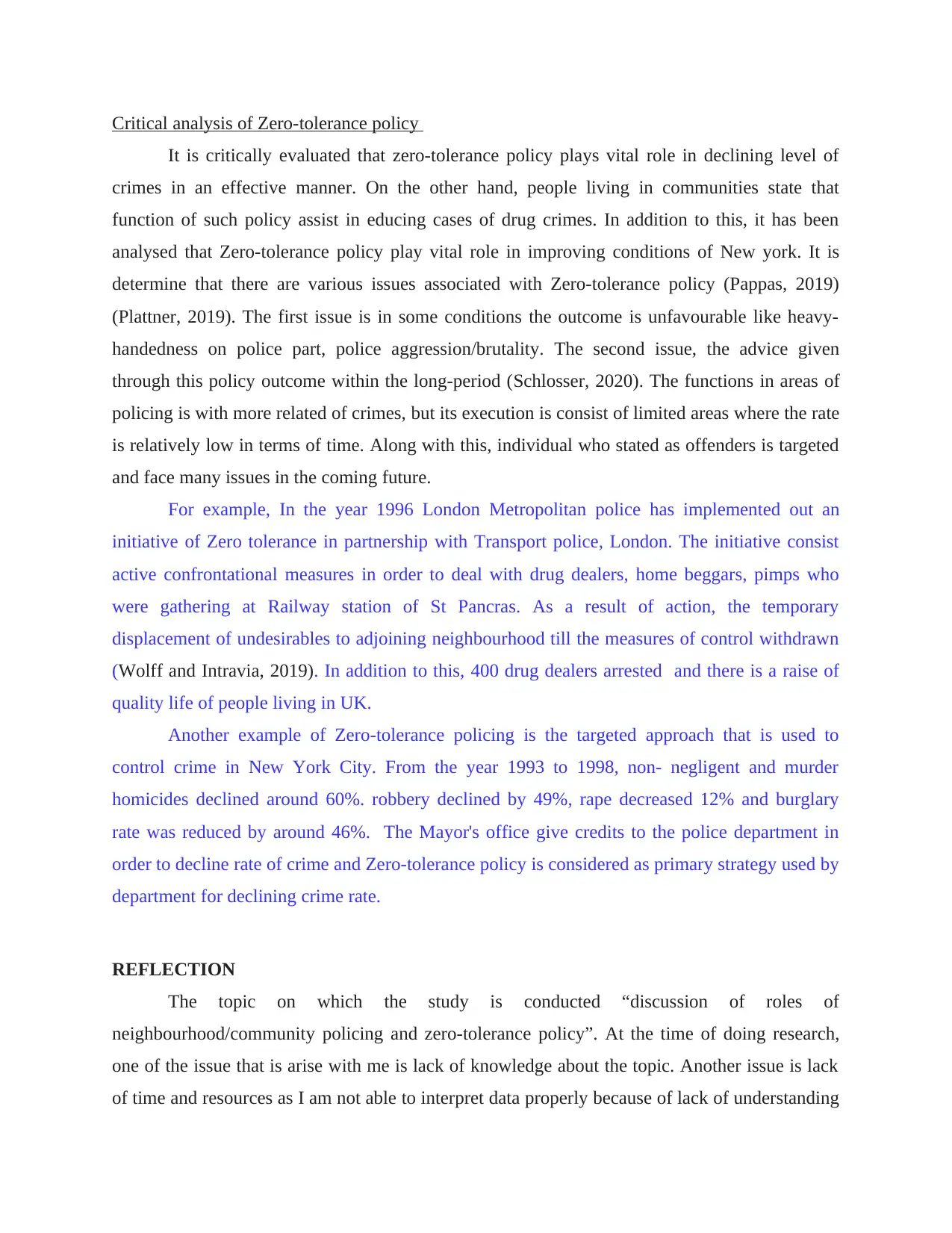
Critical analysis of Zero-tolerance policy
It is critically evaluated that zero-tolerance policy plays vital role in declining level of
crimes in an effective manner. On the other hand, people living in communities state that
function of such policy assist in educing cases of drug crimes. In addition to this, it has been
analysed that Zero-tolerance policy play vital role in improving conditions of New york. It is
determine that there are various issues associated with Zero-tolerance policy (Pappas, 2019)
(Plattner, 2019). The first issue is in some conditions the outcome is unfavourable like heavy-
handedness on police part, police aggression/brutality. The second issue, the advice given
through this policy outcome within the long-period (Schlosser, 2020). The functions in areas of
policing is with more related of crimes, but its execution is consist of limited areas where the rate
is relatively low in terms of time. Along with this, individual who stated as offenders is targeted
and face many issues in the coming future.
For example, In the year 1996 London Metropolitan police has implemented out an
initiative of Zero tolerance in partnership with Transport police, London. The initiative consist
active confrontational measures in order to deal with drug dealers, home beggars, pimps who
were gathering at Railway station of St Pancras. As a result of action, the temporary
displacement of undesirables to adjoining neighbourhood till the measures of control withdrawn
(Wolff and Intravia, 2019). In addition to this, 400 drug dealers arrested and there is a raise of
quality life of people living in UK.
Another example of Zero-tolerance policing is the targeted approach that is used to
control crime in New York City. From the year 1993 to 1998, non- negligent and murder
homicides declined around 60%. robbery declined by 49%, rape decreased 12% and burglary
rate was reduced by around 46%. The Mayor's office give credits to the police department in
order to decline rate of crime and Zero-tolerance policy is considered as primary strategy used by
department for declining crime rate.
REFLECTION
The topic on which the study is conducted “discussion of roles of
neighbourhood/community policing and zero-tolerance policy”. At the time of doing research,
one of the issue that is arise with me is lack of knowledge about the topic. Another issue is lack
of time and resources as I am not able to interpret data properly because of lack of understanding
It is critically evaluated that zero-tolerance policy plays vital role in declining level of
crimes in an effective manner. On the other hand, people living in communities state that
function of such policy assist in educing cases of drug crimes. In addition to this, it has been
analysed that Zero-tolerance policy play vital role in improving conditions of New york. It is
determine that there are various issues associated with Zero-tolerance policy (Pappas, 2019)
(Plattner, 2019). The first issue is in some conditions the outcome is unfavourable like heavy-
handedness on police part, police aggression/brutality. The second issue, the advice given
through this policy outcome within the long-period (Schlosser, 2020). The functions in areas of
policing is with more related of crimes, but its execution is consist of limited areas where the rate
is relatively low in terms of time. Along with this, individual who stated as offenders is targeted
and face many issues in the coming future.
For example, In the year 1996 London Metropolitan police has implemented out an
initiative of Zero tolerance in partnership with Transport police, London. The initiative consist
active confrontational measures in order to deal with drug dealers, home beggars, pimps who
were gathering at Railway station of St Pancras. As a result of action, the temporary
displacement of undesirables to adjoining neighbourhood till the measures of control withdrawn
(Wolff and Intravia, 2019). In addition to this, 400 drug dealers arrested and there is a raise of
quality life of people living in UK.
Another example of Zero-tolerance policing is the targeted approach that is used to
control crime in New York City. From the year 1993 to 1998, non- negligent and murder
homicides declined around 60%. robbery declined by 49%, rape decreased 12% and burglary
rate was reduced by around 46%. The Mayor's office give credits to the police department in
order to decline rate of crime and Zero-tolerance policy is considered as primary strategy used by
department for declining crime rate.
REFLECTION
The topic on which the study is conducted “discussion of roles of
neighbourhood/community policing and zero-tolerance policy”. At the time of doing research,
one of the issue that is arise with me is lack of knowledge about the topic. Another issue is lack
of time and resources as I am not able to interpret data properly because of lack of understanding
⊘ This is a preview!⊘
Do you want full access?
Subscribe today to unlock all pages.

Trusted by 1+ million students worldwide
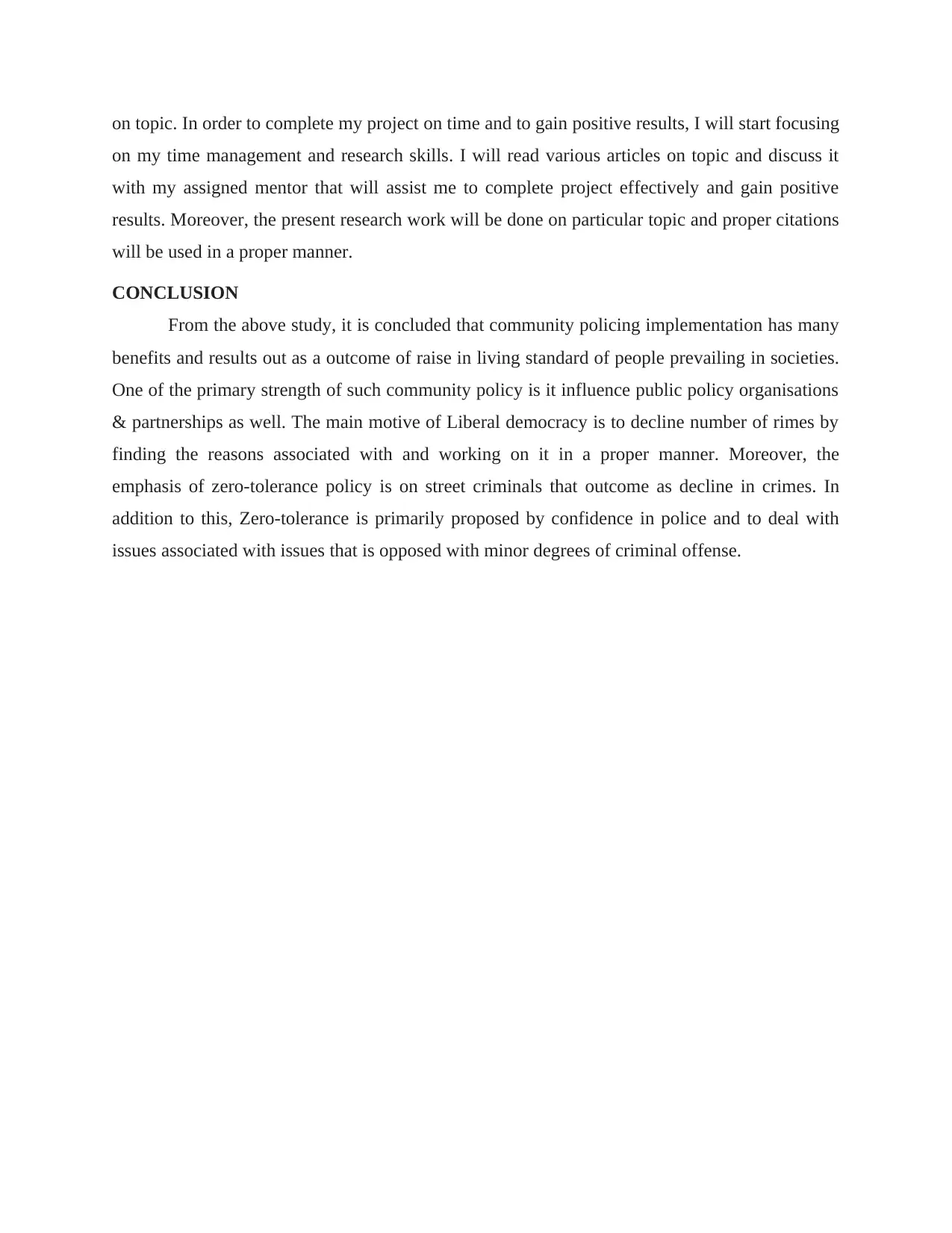
on topic. In order to complete my project on time and to gain positive results, I will start focusing
on my time management and research skills. I will read various articles on topic and discuss it
with my assigned mentor that will assist me to complete project effectively and gain positive
results. Moreover, the present research work will be done on particular topic and proper citations
will be used in a proper manner.
CONCLUSION
From the above study, it is concluded that community policing implementation has many
benefits and results out as a outcome of raise in living standard of people prevailing in societies.
One of the primary strength of such community policy is it influence public policy organisations
& partnerships as well. The main motive of Liberal democracy is to decline number of rimes by
finding the reasons associated with and working on it in a proper manner. Moreover, the
emphasis of zero-tolerance policy is on street criminals that outcome as decline in crimes. In
addition to this, Zero-tolerance is primarily proposed by confidence in police and to deal with
issues associated with issues that is opposed with minor degrees of criminal offense.
on my time management and research skills. I will read various articles on topic and discuss it
with my assigned mentor that will assist me to complete project effectively and gain positive
results. Moreover, the present research work will be done on particular topic and proper citations
will be used in a proper manner.
CONCLUSION
From the above study, it is concluded that community policing implementation has many
benefits and results out as a outcome of raise in living standard of people prevailing in societies.
One of the primary strength of such community policy is it influence public policy organisations
& partnerships as well. The main motive of Liberal democracy is to decline number of rimes by
finding the reasons associated with and working on it in a proper manner. Moreover, the
emphasis of zero-tolerance policy is on street criminals that outcome as decline in crimes. In
addition to this, Zero-tolerance is primarily proposed by confidence in police and to deal with
issues associated with issues that is opposed with minor degrees of criminal offense.
Paraphrase This Document
Need a fresh take? Get an instant paraphrase of this document with our AI Paraphraser
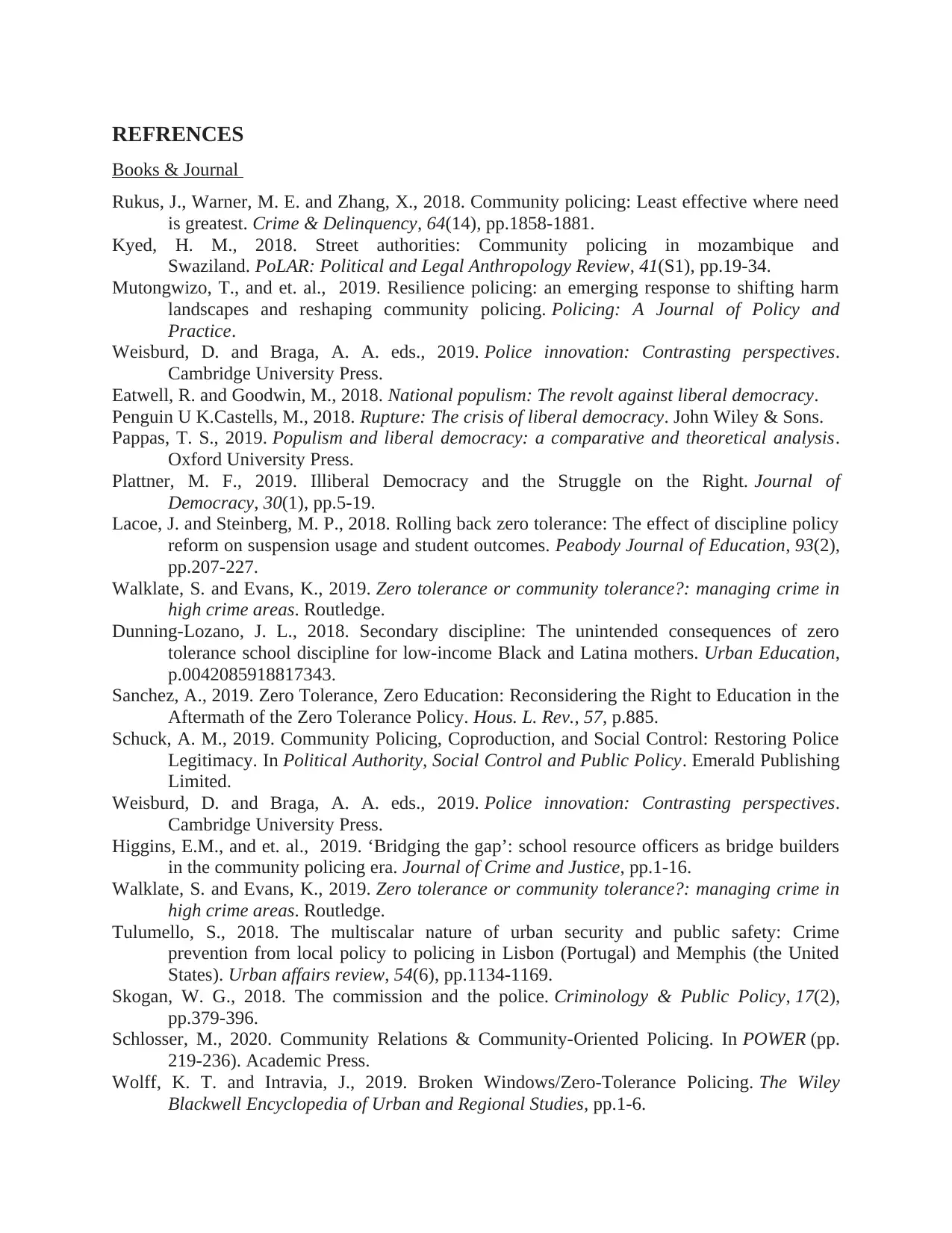
REFRENCES
Books & Journal
Rukus, J., Warner, M. E. and Zhang, X., 2018. Community policing: Least effective where need
is greatest. Crime & Delinquency, 64(14), pp.1858-1881.
Kyed, H. M., 2018. Street authorities: Community policing in mozambique and
Swaziland. PoLAR: Political and Legal Anthropology Review, 41(S1), pp.19-34.
Mutongwizo, T., and et. al., 2019. Resilience policing: an emerging response to shifting harm
landscapes and reshaping community policing. Policing: A Journal of Policy and
Practice.
Weisburd, D. and Braga, A. A. eds., 2019. Police innovation: Contrasting perspectives.
Cambridge University Press.
Eatwell, R. and Goodwin, M., 2018. National populism: The revolt against liberal democracy.
Penguin U K.Castells, M., 2018. Rupture: The crisis of liberal democracy. John Wiley & Sons.
Pappas, T. S., 2019. Populism and liberal democracy: a comparative and theoretical analysis.
Oxford University Press.
Plattner, M. F., 2019. Illiberal Democracy and the Struggle on the Right. Journal of
Democracy, 30(1), pp.5-19.
Lacoe, J. and Steinberg, M. P., 2018. Rolling back zero tolerance: The effect of discipline policy
reform on suspension usage and student outcomes. Peabody Journal of Education, 93(2),
pp.207-227.
Walklate, S. and Evans, K., 2019. Zero tolerance or community tolerance?: managing crime in
high crime areas. Routledge.
Dunning-Lozano, J. L., 2018. Secondary discipline: The unintended consequences of zero
tolerance school discipline for low-income Black and Latina mothers. Urban Education,
p.0042085918817343.
Sanchez, A., 2019. Zero Tolerance, Zero Education: Reconsidering the Right to Education in the
Aftermath of the Zero Tolerance Policy. Hous. L. Rev., 57, p.885.
Schuck, A. M., 2019. Community Policing, Coproduction, and Social Control: Restoring Police
Legitimacy. In Political Authority, Social Control and Public Policy. Emerald Publishing
Limited.
Weisburd, D. and Braga, A. A. eds., 2019. Police innovation: Contrasting perspectives.
Cambridge University Press.
Higgins, E.M., and et. al., 2019. ‘Bridging the gap’: school resource officers as bridge builders
in the community policing era. Journal of Crime and Justice, pp.1-16.
Walklate, S. and Evans, K., 2019. Zero tolerance or community tolerance?: managing crime in
high crime areas. Routledge.
Tulumello, S., 2018. The multiscalar nature of urban security and public safety: Crime
prevention from local policy to policing in Lisbon (Portugal) and Memphis (the United
States). Urban affairs review, 54(6), pp.1134-1169.
Skogan, W. G., 2018. The commission and the police. Criminology & Public Policy, 17(2),
pp.379-396.
Schlosser, M., 2020. Community Relations & Community-Oriented Policing. In POWER (pp.
219-236). Academic Press.
Wolff, K. T. and Intravia, J., 2019. Broken Windows/Zero‐Tolerance Policing. The Wiley
Blackwell Encyclopedia of Urban and Regional Studies, pp.1-6.
Books & Journal
Rukus, J., Warner, M. E. and Zhang, X., 2018. Community policing: Least effective where need
is greatest. Crime & Delinquency, 64(14), pp.1858-1881.
Kyed, H. M., 2018. Street authorities: Community policing in mozambique and
Swaziland. PoLAR: Political and Legal Anthropology Review, 41(S1), pp.19-34.
Mutongwizo, T., and et. al., 2019. Resilience policing: an emerging response to shifting harm
landscapes and reshaping community policing. Policing: A Journal of Policy and
Practice.
Weisburd, D. and Braga, A. A. eds., 2019. Police innovation: Contrasting perspectives.
Cambridge University Press.
Eatwell, R. and Goodwin, M., 2018. National populism: The revolt against liberal democracy.
Penguin U K.Castells, M., 2018. Rupture: The crisis of liberal democracy. John Wiley & Sons.
Pappas, T. S., 2019. Populism and liberal democracy: a comparative and theoretical analysis.
Oxford University Press.
Plattner, M. F., 2019. Illiberal Democracy and the Struggle on the Right. Journal of
Democracy, 30(1), pp.5-19.
Lacoe, J. and Steinberg, M. P., 2018. Rolling back zero tolerance: The effect of discipline policy
reform on suspension usage and student outcomes. Peabody Journal of Education, 93(2),
pp.207-227.
Walklate, S. and Evans, K., 2019. Zero tolerance or community tolerance?: managing crime in
high crime areas. Routledge.
Dunning-Lozano, J. L., 2018. Secondary discipline: The unintended consequences of zero
tolerance school discipline for low-income Black and Latina mothers. Urban Education,
p.0042085918817343.
Sanchez, A., 2019. Zero Tolerance, Zero Education: Reconsidering the Right to Education in the
Aftermath of the Zero Tolerance Policy. Hous. L. Rev., 57, p.885.
Schuck, A. M., 2019. Community Policing, Coproduction, and Social Control: Restoring Police
Legitimacy. In Political Authority, Social Control and Public Policy. Emerald Publishing
Limited.
Weisburd, D. and Braga, A. A. eds., 2019. Police innovation: Contrasting perspectives.
Cambridge University Press.
Higgins, E.M., and et. al., 2019. ‘Bridging the gap’: school resource officers as bridge builders
in the community policing era. Journal of Crime and Justice, pp.1-16.
Walklate, S. and Evans, K., 2019. Zero tolerance or community tolerance?: managing crime in
high crime areas. Routledge.
Tulumello, S., 2018. The multiscalar nature of urban security and public safety: Crime
prevention from local policy to policing in Lisbon (Portugal) and Memphis (the United
States). Urban affairs review, 54(6), pp.1134-1169.
Skogan, W. G., 2018. The commission and the police. Criminology & Public Policy, 17(2),
pp.379-396.
Schlosser, M., 2020. Community Relations & Community-Oriented Policing. In POWER (pp.
219-236). Academic Press.
Wolff, K. T. and Intravia, J., 2019. Broken Windows/Zero‐Tolerance Policing. The Wiley
Blackwell Encyclopedia of Urban and Regional Studies, pp.1-6.

⊘ This is a preview!⊘
Do you want full access?
Subscribe today to unlock all pages.

Trusted by 1+ million students worldwide
1 out of 9
Related Documents
Your All-in-One AI-Powered Toolkit for Academic Success.
+13062052269
info@desklib.com
Available 24*7 on WhatsApp / Email
![[object Object]](/_next/static/media/star-bottom.7253800d.svg)
Unlock your academic potential
Copyright © 2020–2025 A2Z Services. All Rights Reserved. Developed and managed by ZUCOL.





